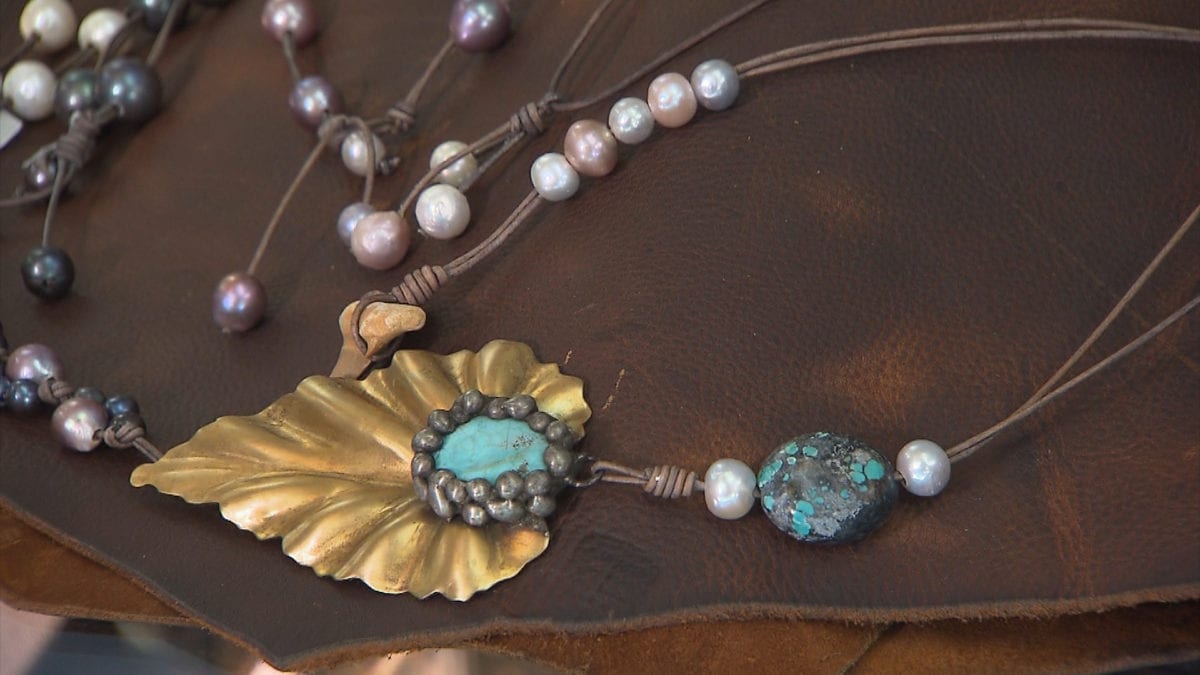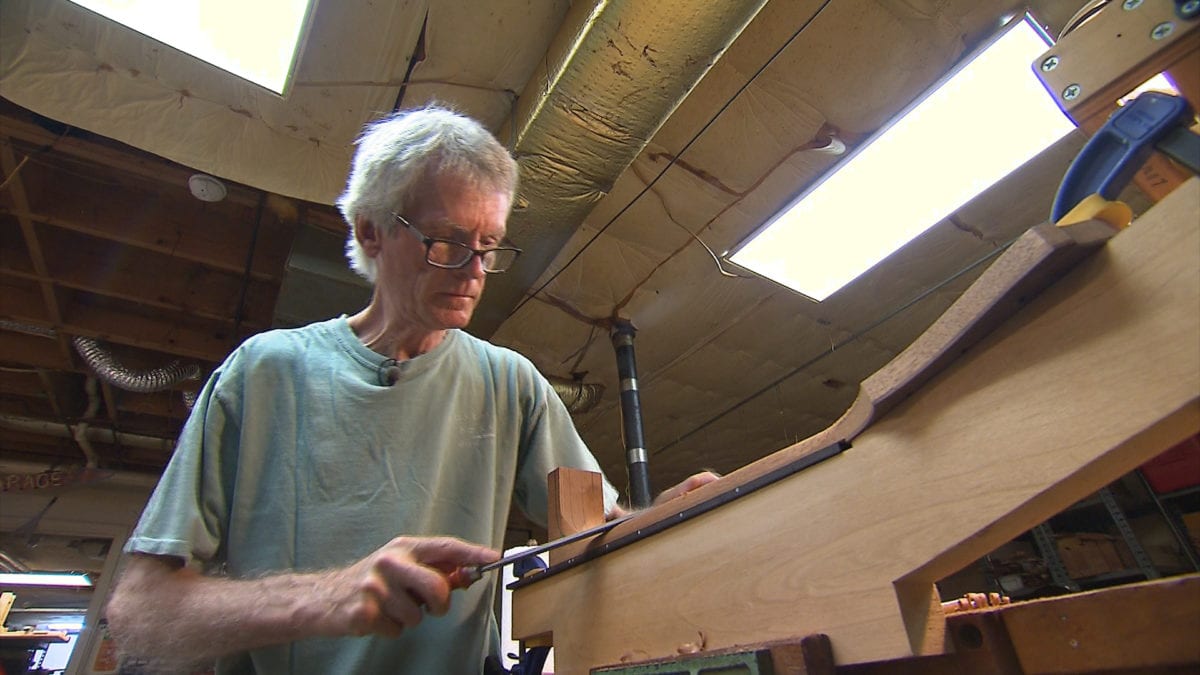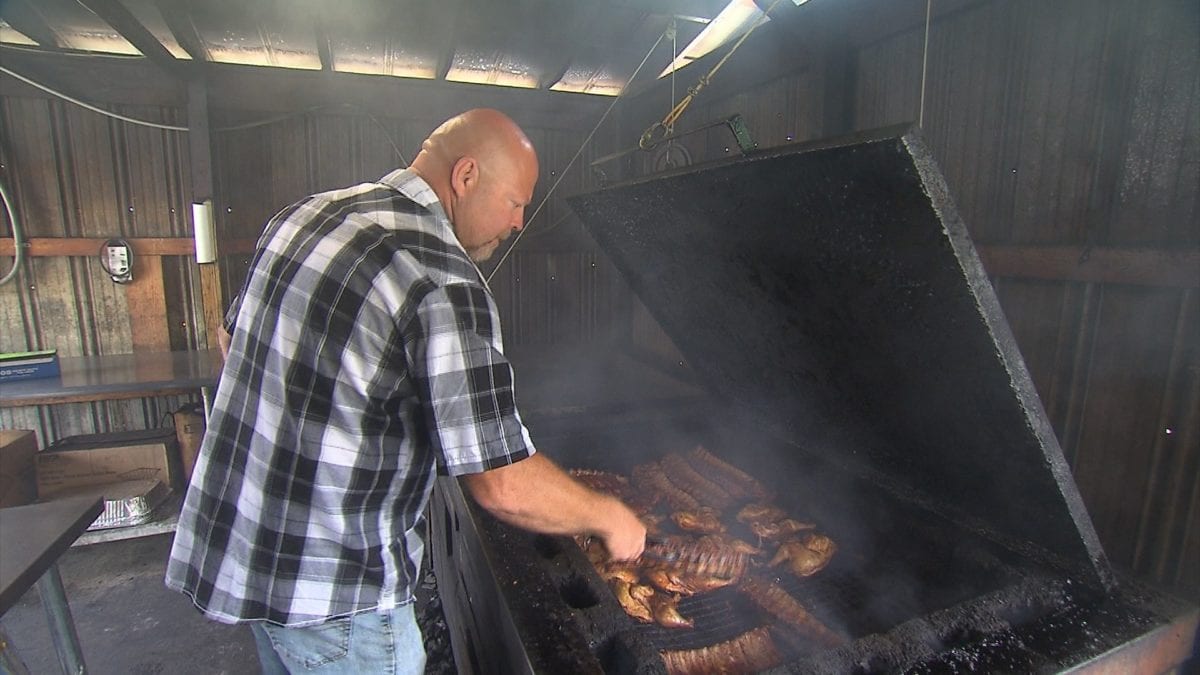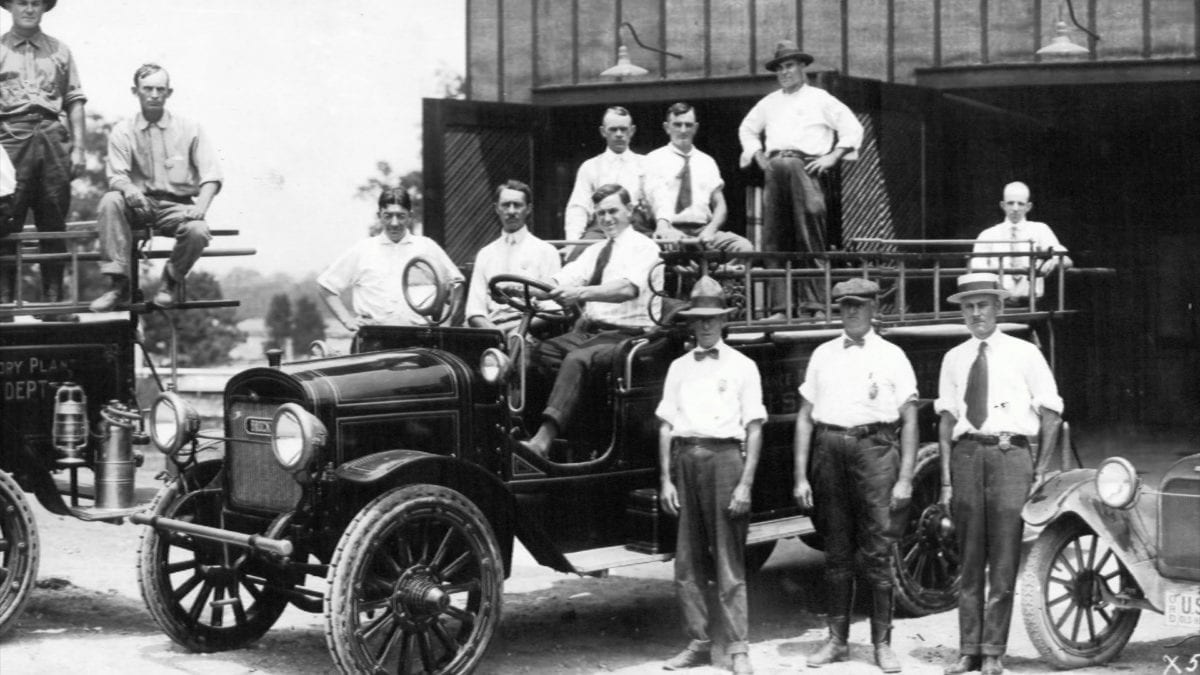Episode 3439
Don't have the PBS App? Click Here
Episode Transcript
- This time on Tennessee Crossroads we first visit Lucky Pearl Designs in Lebanon, then feast on some Lynchburg style barbecue, we'll meet a guitar maker for music royalty, and finally discover the explosive history of Old Hickory, Tennessee. Hi everybody, I'm Joe Elmore. That's the lineup. This is Tennessee Crossroads. Welcome. It's hard to believe, but there may be one thing every U.S. President has agreed on, or at least their wives have agreed on. You see nearly every first lady in history has worn pearls. Seems like the treasured natural element has never been more popular. Well, Miranda Cohen takes us to Lebanon, where one jewelry maker is giving this rare gem a Tennessee twist. - [Miranda] Luxurious and elegant, is there anything more beautiful than the classic pearl? Pearls have been around for thousands of years, the coveted jewel of royalty and celebrities alike. - I've always loved pearls myself. My mother and grandmother wore them. Most of the first ladies have worn them. So they're timeless. I mean, they have a place in history. - [Miranda] Julie Grisham is the owner of Lucky Pearl Designs on the Square in Lebanon, Tennessee, and she is turning these rare organic gems into exquisite works of wearable art. - You know, honestly, I'm inspired by the pearls themselves. They are just the element. It's just the most beautiful, pearls are called the gem of queens and the queen of gems. - [Miranda] And Grisham is giving the elegant bauble a rustic flair and the results are absolutely gorgeous. - Our jewelry is kind of a twist on the classic pearl necklace. We add the leather. So everything we make has leather. It's hand-rolled leather cord, but all of it's leather and pearls. So it's kind of a twist on the old classic pearl necklace. - [Miranda] Lucky Pearl Designs' slogan is they're Not Your Grandmother's Pearls, but her unique and one of a kind creations are appealing to every generation. - The look that it creates is just so unique and so different, and pearls and leather, both natural elements, so they kind of go together. And they, you know, we think they create an amazing look. You have to keep trying to do that to stay current. You have to keep so your work doesn't get old or just kind of get stagnant in your designs. - [Miranda] The Grisham's three daughters help keep them trendy, and coming to work is a real family affair. - Well, my husband drills all the pearls. I run the shop and make the jewelry. My younger two daughters help in the shop when we need them. When we're particularly busy during the holidays and that kind of thing. And my oldest daughter pretty much manages our social media. - [Miranda] Julie Grisham says only about 30% of oysters will actually ever produce a pearl. She works with a pearl farm in West Tennessee to find the exact shape, size, and color she wants. - Our pearls, mostly we use freshwater pearls. We do, however, use some of the South Sea and Tahitian pearls. And freshwater pearls tend to come from rivers. The Tahitian pearls come from French Polynesia, mostly the lagoons, so it's more of a still water oyster. - Most of the time you think of pearls, you think of them in white or ivory, but here at Lucky Pearl Designs they have pearls in many different brilliant hues, and it's all determined by the oyster itself. The temperature of the water, the sediment, the water flow, even the nutrients the oysters take in. Husband, Barry Grisham, will then painstakingly drill every pearl. Julie will masterfully thread and manipulate the pearls into necklaces, bracelets, earrings, and more. - So we drill the pearls for this one, so that you can actually, instead of a single piece of leather, we put two pieces of leather through it. And that way, when we complete this, you're going to be able to move the pearls on the leather and have them remain stationary. And it's one of our most popular items. - [Miranda] And one of her most popular items is where high fashion meets high tech. - [Julie] Well, one of our most popular sellers is we make a band for the Apple watch. Double wrap or a single wrap band, and we use the Apple approved hardware. - [Miranda] And not everything that is beautifully displayed on this authentic Tennessee river driftwood is made of pearls. Grisham also custom designs handmade pieces from old keys, ancient coins, and even rare treasured artifacts from all over the world. - Beautiful Byzantine crosses from the 15th to 18th century Russia, authentic, you know, these old crosses. Apparently they were very popular back in their day because there are a lot of them, and they're actually, you know, artifacts, it's like wearing a piece of history. We have a source for some shipwreck coins that are authentic. And so, from the 1600's, some of them. Some of them are from the 1800's and you can actually see the date. And these are coins, a lot of times people bring us an old coin that they've gotten from a family member that's been sitting around in a drawer, and they bring the piece to us and then we incorporate it into a necklace, or bracelet, or whatever they might want. - [Miranda] And it's not only the ladies that are sporting these unique pieces. - Men are particularly interested in the shipwreck coins. I think they like that bit of history and the pirate thing. - [Miranda] Natural elements coming together to form exquisite pieces of art and history, both rustic and rare, grace and elegance, all masterfully crafted gifts anyone would be lucky to get. - Pearls are just beautiful and natural, and when you have access to the beautiful ones that we have, you want to do something beautiful with them. - Thanks Miranda. In addition to the Jack Daniels Distillery, Lynchburg has become quite famous for its annual International Barbecue Competition. Well, anytime of the year you can find barbecue in Lynchburg if you know where to look. We looked just beyond the town square and discovered a place that's made famous thanks to a quirky sandwich. Some say the taste of Jack Daniel's Tennessee Whiskey comes from the iron free water and hard sugar maple charcoal filtering. Well, either way after it's aged in charcoal lined barrels, about 150 million bottles are filled here annually. Plus, the distillery is a destination for about a third of a million people each year come from around the globe. After watching them make whiskey and touring the town square, maybe buying a few souvenirs, might be time for lunch at a place where some of those barrels are put to good use. Chuck Baker was a brick mason before opening Barrel House Barbecue in 2012. It's located just off the Lynchburg Town Square. It was a brave move for a guy who had no professional barbecue experience. - I cooked at home, but never nothing like this, but I just wanted to do something different. I wanted change, and this is what I chose. Everything just came together. It's worked real well. - [Joe] To get it going on a tight budget, Chuck made all of his own furniture with lots of hard work and used whiskey barrels. - And I used a buddy of mine's old cattle barn to put all my woodworking equipment in and I made all my furniture in his barn. This right here where we're sitting, this used to be this wall. It was a solid wall. My momma came up with this idea of me making this into a bar. And it was really cool that she was the one that come up with it. - [Joe] And it looks like customers have eagerly accepted the invitation to write on everything from the tables to the walls. - [Joe] Now, what about the lighting? - Well, a good friend of mine, he's an electrician, and I saw this on Facebook, so I had him make these for me, and I didn't drink all of it, but I think some of it. Most of it was used for cooking. - [Joe] Okay. - Yeah. The heart of his operation is a concrete block pit that, yes, Chuck made himself. - I decided that I would try it that way and just build a block pit in the ground. and I think that's probably probably part of the success is I'm not using the commercial oven type thing. I'm cooking old school and people seem to appreciate it. - [Joe] Of course, no barbecue technique is complete without a special sauce. - Yeah, I don't give away all the secrets, but of course it does have Jack Daniels in it. You know, I'm in Lynchburg, so it had to be one of the ingredients. - [Joe] While the baby back ribs, chicken, and sausage are big hits, his claim to fame is a sandwich consisting of pulled pork and cheese. - The Grilled Cheese on Crack. - [Joe] He came by it one night accidentally while trying to feed his daughter. - So I come back out of the kitchen. I said, "How about a grilled cheese?" And she said, "That's fine." So I went in and got the bread and I opened up the refrigerator to get the cheese out, and there was a little styrofoam cup, it was about halfway full of pulled pork one of my girls had stuck in there. So I warmed it up right quick, and I put it between the cheese, put her some habanero sauce on there, done it like a grilled cheese, you know, toasted on the grill. Carried it to her and I said, "Here, give this a try. I fattened it up for you." And I went back out to the smokehouse and came back in a few minutes later. And when I walked in and she's taking the last bite and she said, "Daddy, this is like grilled cheese on crack." And then when she said that, I said, I told her, I said I'm gonna put that on my menu one day, and the next time I got menus, I did. - [Joe] Don't laugh, Grilled Cheese on Crack has received high ratings and honors from national food critics. - The Grilled Cheese on Crack, it's definitely the number one thing, but the ribs are right behind it. We do real good baby back ribs. And the smoked sausage is to die for. - [Joe] During this weekday noon hour, the place was filled, not only with locals, but visitors from far away States. These people had come from Arizona on their third annual visit. - We really enjoy the food here. Hospitality is outstanding, so we like to come back. - [Joe] Now, your dad got the ribs, you chose chopped barbecue. - Yeah, the pulled pork plate. Very good barbecue, it's hard to come by back home, so it's nice to be able to get some good food. - Here we go! - I got the prettiest waitress in town. - [Joe] In addition to good food, some restaurants have that good friendly vibe you feel when you walk inside the door. This place has got it. And Chuck's quick to credit his young friendly staff with helping make it happen. - I have an excellent staff and I kind of worked this thing like I did my masonry business. I'm not hard on them but I've made sure that they understand that everybody comes in that door is important, and we're here to take care of them. Every day, I have people from all parts of this planet and it's just pretty cool, very cool. - Have you ever heard of a company town? Well, years ago when corporations built a factory, they often built a town to go with it. Such was the case with the city of Old Hickory, Tennessee, which was literally built by DuPont. While it's no longer a company town, it still retains the neighborly charm it started with a century ago. - [Ed] Since its founding in 1918, the charming Hamlet of Old Hickory has seen generations of Davidson County residents come and go. It's quaint homes and picturesque surroundings stand in stark contrast to the violent conflict which led to its creation. The war to end all wars created a desperate need for gunpowder, which was the specialty of the DuPont corporation. The U.S. government contracted with DuPont to build the largest gunpowder plant in the world, and the town as well, as Old Hickory historian, Kris Brummett, explains. - Ground was broken for the gun powder facility in March of 1918, and this area was barely populated. There were only a handful of farmers who lived here. There was a rush for employment for the gun powder plant because a lot of people were being deployed. And so, they ended up recruiting people from Mexico, from other countries, they brought in people from other States. And then by July, they produced the first gunpowder. And from that first gun powder production they just continued to increase their construction and moving towards full capacity at a rapid pace. Of course, the war ended in November of 1918, which meant there was no longer a need for gunpowder. So the government and DuPont both left Old Hickory. In that nine month period, there were probably 30 to 50,000 people living within the area. And overnight the population dropped to about 500 people. The area became a ghost town in the following years. - [Ed] But destiny wasn't finished with Old Hickory. Having constructed a modern factory and housing for 35,000, DuPont would soon return to the village it had created, not to help wage war, but weave wardrobes. - In 1923, DuPont decided to move back to the area and built a rayon factory. Rayon was initially called fiber silk and was used in clothing and other materials. So they returned and they renovated the village and they rented out each house to their employees. So it was basically a company run town. They owned the houses, they owned the fire department, they owned the police department, they operated the schools, they were in charge of the entertainment. And what you would see with DuPont is that they really fostered the children of their employees and their reasoning behind this was that they wanted to someday raise these children to become their workers. So, they really watched out for their children. And it was a company town until around 1949 through 1952, they started selling off the houses, and of course many of the employees would buy these houses, and continue to live in Old Hickory. DuPont did not want their workers leaving the area, so they tried to provide as much as they could in the way of entertainment, in the way of food, shopping, selling goods and services. They tried to keep it in this area. So they really built up a full-scale town. I began working at DuPont 28 years ago and I just fell in love with the whole area. And over that time, living here and working here, I just developed a genuine interest in the history. - [Ed] Kris' interest in that history extended to long-term residents of old Hickory, and she took it upon herself to record their memories. - Back then, I mean, we were just sort of a family because all of our parents worked for DuPont. Once a year, DuPont would have a picnic for all their employees over on the river bank. And I said, I still remember that watermelon, and ice cream, and everything. At Christmas time, they'd always have a party for the employees. I mean, they spoiled us, DuPont spoiled us, they really did. - Oh, I thought I was rich, living in these houses from out in the country. Yeah, I thought I was rich because we had a bathroom, we had lights and water in the house, and all that. We just thought we were rich almost. - [Kris] DuPont wanted to develop recreation facilities for their employees, so they installed a swimming pool in this area. - We moved here in 1933, the swimming pool was open and it had showers in the back, wooden showers. And it had a free hour. - [Kris] What was free hour? - Well, they owned the pool, and they knew that people didn't have a lot of money. So we were barefooted, wearing overall. Like I said, my dad made 12 dollars and a half, put 40 hours, and had four kids. It only cost a nickel to get in, but they had free hour, which means that from certain hour, you could go up there and swim free, but you had to be clean before you went in, and then we thought that was the greatest thing in the world. - [Ed] While Old Hickory continues to attract industries, long gone are it's days as a company town. However, it still retains the history and charm of a century ago. - Old Hickory is experiencing a revitalization. People are moving in and renovating houses. We have a lot of people who are really interested in being a part of who we are. - The master craftsmen in our next story is originally from England, but his love for making fine instruments brought him to music city nearly 40 years ago. Since then he's built or repaired guitars for rock and roll royalty from Aerosmith to U2. Cindy Carter discovered the wonderful stories behind Lacey guitars. - Gets it up to about 300 degrees. - [Cindy] After 45 years of carefully bending, hammering, and cutting pieces of wood into specific shapes and sizes, guitar maker, Mark Lacey, can competently answer the question every professional, amateur, and wanna-be musician asks. - What constitutes a great guitar? Well, it's got to feel comfortable in your hands, it's got a play in tune, it's got to look good, and it's got to have structural integrity. - [Cindy] Integrity is a pretty powerful word for Mark, after all it's his name carefully carved into his finished pieces. - [Mark] Well, I just really enjoy what I do and it encompasses quite a few different skill sets striving to make the perfect guitar. - [Cindy] Inside his Kingston Springs basement under the watchful eyes of his trusted companion, Cowboy, Mark patiently, very patiently, works through the many steps required when one builds an instrument from raw materials. - Nice ring to it. - [Cindy] Born in Australia, Mark grew up in London, where as a young man, the London College of Furniture caught his attention. - One day I was looking through a careers book and I saw a course on musical instrument technology. - [Cindy] Technology, yeah, but Mark says what he really got was a strong foundation for working with his hands, intricate, delicate, tricky, often complex handiwork, work that initially in his professional career centered around instrument repairs. - Really your bread and butter living in this business, for a lot of people, is doing repairs. You know, you've got the cashflow, building projects can sometimes take months, but those repairs will help pay the bills. - [Cindy] After school, Mark eventually moved to the U.S. and settled in Los Angeles, where for more than a decade he paid the bills doing repair work for an impressive client list. The soft-spoken artist isn't comfortable dropping names. We had to prod him a bit. - [Mark] I've done repair work for Stevie Ray Vaughan, Paul McCartney, Pink Floyd, so many it's hard to remember them. - [Cindy] But the whole time he was in California, Mark was dreaming about doing less repair and more building. His vision, his designs. - I like to do original designs because why copy something else? - [Cindy] Moving to Tennessee allowed him to finally tip the scales in that direction. Competently, successfully, but somewhat quietly. He's just not a flashy guy. - You know, I've been here since '95, and I guess I'm sort of been under the radar a bit. You know, being out here in Kingston Springs, I don't go around and network a lot, and hit the clubs, just you know, meet the bands. or try and get backstage. - [Cindy] Mark essentially makes four types of guitars, flattop, arch top, semi-solid electric, and recently some bass guitars, he admits for purely selfish reasons. - [Mark] I've always been a bass player more than a guitar player, and I had some ideas about how to build a base that didn't weigh as much, that resonated more, so I experimented around. - [Cindy] Those experiments include using different woods, shells, and other raw materials for the guitar body, the neck, which contribute to the instruments overall sound. - Different guitars use different traditional woods, like arch tops are mostly made with a fig and maple, and a spruce top. And the maple was either Eastern maple or West Coast maple. Flat top guitars, traditionally Rosewood with Spruce or Cedar tops, Mahogany necks. - [Cindy] Mark has figured out a few of the finer points along the way, but remains grateful for those early years in school where learning how to build fretted instruments shaped his current decorative and intricate style. - [Mark] They get inlaid into these channels. - [Cindy] As impressive as his literal handiwork is, Mark doesn't shy away from technology, also using this computer numerical control, or CNC cutting machine, to carve out some of his guitar parts. - You know, I draw the design in the computer, computer will write the code and prepare what's called a processor file, which the machine can read. - Sometimes the client tells Mark to go for it, other times they just want something very specific, but no matter what the job, Mark's creative flair can always be found in the end result. Like the time a client wanted Mark to build a guitar around his fiance's personality. A red head who liked her horse, sea turtles, owls, and is partial to blue instruments. Okay. - On the headstock, I put a sea turtle, and I made it out different kinds of shell. For the horse, I put it on the Picard, and the tailpiece, which was metal, had an owl in there sort of in the woods at night, and then in the background is the trees and leaves. It was a very ornate piece to do. - [Cindy] Western Red Cedar, underscore red, was used for the top of the guitar and blue sunburst on the back and sides completed the look. Everybody was pleased. - And that's what gives me the satisfaction. If they're happy, I'm happy. - [Cindy] And Mark is happy. He's got a Cowboy at his side, a humming business, and he gets to answer the question over and over, what constitutes a great guitar? - Well that winds up this edition of Tennessee Crossroads. Sure glad to have you. Hope you had a good time and hope you'll check in on our website occasionally, TennesseeCrossroads.org. Follow us on Facebook and please join us next time.
Tennessee Crossroads
May 27, 2021
Season 34 | Episode 39
Miranda Cohen takes us to Lebanon where one jewelry maker is giving the rare gem a tennessee twist. Joe Elmore visits Barrel BBQ in Lynchburg. Ed Jones delves into the explosive history of Old Hickory, Tennessee. And Cindy Carter meets a guitar maker for rock superstars. Presented by Nashville Public Television.




